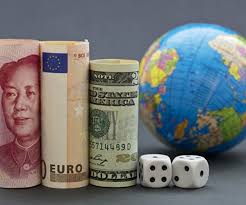Article published originally here.
The primary purposes of the incorrectly named “unconventional monetary policies” are to debase the currency, stoke inflation, and make exports more competitive. Printing money aims to solve structural imbalances by making currencies weaker.
In this race to zero in global currency wars, central banks today are “printing” more than $200 billion per month despite that the financial crisis passed a long time ago.
Currency wars are those that no one admits to waging, but everyone wants to fight in secret. The goal is to promote exports at the expense of trading partners.
So how must the bureaucrats at the European Central Bank (ECB) feel when they see the euro rise against the U.S. dollar and all its main trading currencies by more than 12 percent in a year, despite all the talk about more easing? The ECB will keep buying 60 billion euro a month in bonds, maintain its zero interest-rate policy, and keep this “stimulus” as long as it takes, until inflation growth and GDP growth are stable.
Contrary to the wishes of the ECB, however, a strong euro is justified for several reasons. First, the European Union’s trade surplus is at record highs, and 75 percent of Eurozone trade happens between Eurozone countries. Higher exports and the continued recovery of internal demand in European member countries strengthen the euro.
The third is the perception of weakness of the U.S. government and its inability to push through key reforms. This has weakened the dollar and by definition strengthened the other two large trading currencies, the euro and the Japanese yen.The second important factor is the relief rally after the French and Dutch elections. The fears of a Euro breakup have been eliminated, or at least delayed, as pro-EU political parties won.
The Problems With a Strong Euro
However, a strong euro has very significant implications for the EU economy and the ECB’s policy.
The strong euro puts exports to its main outside trading partners, the United States (20.8 percent of exports in 2016) and China (9.7 percent), at risk. Despite the ECB’s extreme monetary policy and a euro trading almost at parity with the dollar, exports to non-EU countries have stalled since 2013. GDP growth estimates for 2018 are falling due to a lower contribution of net exports.
The currency also has a high impact on tax revenues in Europe. The correlation between the euro–dollar exchange rate and the earnings estimates of the largest multinationals represented in the Stoxx Europe 600 Index is very high.
According to our estimates, a 10 percent rise of the euro against the dollar is equivalent to an 8 percent drop in earnings and leads to lower corporate tax revenues. From an investment perspective, as earnings drop, the European stock market goes from being relatively cheaper to becoming more expensive.
Investors and economists need to pay attention to these factors. If the euro continues to strengthen, the EU economic recovery is at risk. So the Eurozone is stuck between a rock and a hard place. It cannot stop the stimulus because deficit spending governments cannot live with higher financing costs, and increasing the stimulus to weaken the currency simply doesn’t work anymore.
The only way out is structural reforms, but most governments are afraid of them even in good times, let alone when the going gets tough.
Daniel Lacalle is chief economist at investment management company Tressis and author of the recent book “Escape from the Central Bank Trap” (published by BEP).
Courtesy of The Epoch Times. Read here.


 This week we have read that Brussels has certified “the end of the crisis”. In an uncomfortably triumphant
This week we have read that Brussels has certified “the end of the crisis”. In an uncomfortably triumphant 